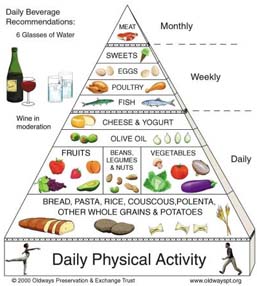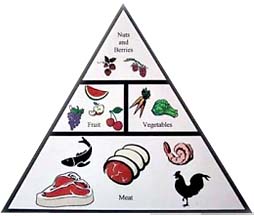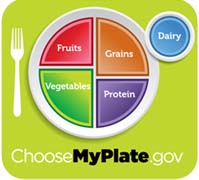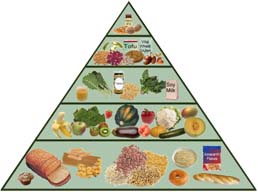Every Nutrition School has a Pyramid, Which One is Yours?
- By Rebecca Taggart
- Reading Time: 5 mins.
Nutrition pyramids are supposed to be graphical representations of a healthy diet. But whose? The latest guidelines issued by the U.S. government emphasize eating more fruits and vegetables and less fat, salt, and sugar, as we reported back in February. But there are as many food pyramids out there as there are food philosophies, from Mediterranean to Paleolithic, from Vegetarian to Vegan, and from locavore Michael Pollan to natural fats promoter Weston Price.
Here we present a synopsis of a variety of eating philosophies and their pyramids (or other graphical devices). Which one is yours?

U.S. Government Dietary Guidelines:
The U.S. Department of Health and Human Services has issued joint dietary guidelines with the U.S. Department of Agriculture every five years since 1980. The 2010 version emphasizes increased physical activity, cutting back on fat, salt and added sugar, and increasing consumption of fruits and vegetables.
The MyPyramid campaign was long criticized as being confusing and not terribly informational for consumers. In June, the pyramid was buried and replaced with a plate.
The graphics have been simplified to give people a better idea of how food groups might look proportionally on your plate. However, ChooseMyPlate.gov makes some of the same mistakes as mypyramid.gov, such as including “fruit cocktail,” generally processed fruit preserved in a sugar syrup, in the “fruits” group. According to the website, “Any fruit or 100% fruit juice counts as part of the Fruit Group. Fruits may be fresh, canned, frozen, or dried, and may be whole, cut-up, or pureed.” Research has shown that the majority of the nutritional benefits of fruits such as apples, pears, and stone fruit reside in the peel of fresh fruit. The guidelines are an improvement over past versions in keeping with newer research, for example, differentiating between different fats and discouraging the consumption of processed foods. The website also offers several tools to monitor your diet and exercise and to plan meals.
Mediterranean Diet:

The Mediterranean Diet Pyramid
The Mediterranean diet is based on the diet consumed by Greeks and Italians in the 1960s, at the time when they had the lowest rates of chronic disease and the highest rates of longevity in the world. Studies found that the diet’s combination of lots of fruits and vegetables, beans and nuts, seafood, little red meat, and small amounts of dairy and red wine contributed to subjects’ good health. Enjoying meals with others as well as moderate daily exercise are also vital components. This diet also focuses on fresh and in-season produce that is minimally-processed. Olive oil replaces butter and other fats and oils, fruit is the main dessert, and red wine is recommended in moderation (1-2 glasses for men per day, one glass for women).
Oldways.com, an international non-profit foundation that promotes traditional diets, sustainable agriculture, and healthy eating and drinking, showcases the Mediterranean diet as the “gold standard” of healthy eating.
Want fruit for your office?
Get your office a free sample TODAY!Slow Food:
The “slow food” movement begun in Italy by Carlo Petrini in the late 1980s as an antidote to “fast food” and to preserve traditional Italian artisan food and the culture of meal enjoyment has spread across the globe. With more than 200 local chapters, Slow Food USA runs a variety of programs to promote local and regional foods and food traditions and safeguard biodiversity, especially the preservation of endangered heirloom foods, such as the Gravenstein Apple. Diet guidelines do not figure directly in slow food’s mission, other than taking time to enjoy food with others, which is considered as important as supporting food traditions and advocating for food and farm policies that are “good for the public, good for farmers and workers, and good for the planet.”
Vegan Diet:
Vegans, by definition, will disagree with recommendations for meat, seafood, and dairy intake. Vegans choose to avoid all animal-based produce, from meat and eggs to milk and honey, as a way to prevent exploitation of animals for food, clothing, or other products. But they do have a pyramid that focuses on legumes, fruits, vegetables, and whole grains. Seeds and nuts provide omega-3 essential fatty acids while daily vegetable intake, or supplements provide Vitamin D and calcium necessary for healthy bone density. From www.veganpeace.com.
Get tips for your office
Be an office hero!Paleolithic Diet:

In clear opposition to the vegan pyramid, the Paleolithic diet is based on the concept that human digestion has evolved fairly little since the era of the Old Stone Age hunter-gatherers some two million years ago. That diet was mostly meat, fish and seafood, some vegetables and fruit, and little nuts and berries.
Weston Price Foundation:
The Weston A. Price Foundation for Wise Traditions in Food, Farming, and Healing Arts promotes the consumption of nutrient-dense whole foods and healthy fats, such as butter, raw milk, cream, cheese, liver, cod liver oil, and seafood. Named for the dentist and diet researcher Weston Price whose travels in the 1930s studying native diets around the world convinced him that animal fats are essential to human health and nutrient absorption, the foundation challenges the USDA guidelines of low-fat, low-sodium, high veggie diets and instead promotes its “Healthy 4 Life Guidelines:
“Every day, eat high quality, whole foods to provide an abundance of nutrients, chosen from each of the following four groups:
- Animal foods: meat and organ meats, poultry, and eggs from pastured animals; fish and shellfish; whole raw cheese, milk, and other dairy products from pastured animals; and broth made from animal bones.
- Grains, legumes, and nuts: whole-grain baked goods, breakfast porridges, whole grain rice; beans and lentils; peanuts, cashews, and nuts, adequately prepared to improve digestibility.
- Fruits and Vegetables: preferably fresh or frozen, preferably locally grown, either raw, cooked or in soups and stews, and also as lacto-fermented condiments.
- Fats and Oils: unrefined saturated and monounsaturated fats including butter, lard, tallow, and other animal fats; palm oil and coconut oil; olive oil; cod liver oil for vitamins A and D.
Avoid foods containing refined sweeteners such as candies, sodas, cookies, cakes, etc.; white flour products such as pasta and white bread; processed foods; modern soy foods; polyunsaturated and partially hydrogenated vegetable oils and fried foods.”
While they do not have a pyramid, the foundation does have a plethora of articles, research, and commentary that challenges many current assumptions about what is a “healthy” diet.
Asian Diet Pyramid and Japanese Top:
Like the Mediterranean diet, the traditional Asian diet of whole grains, fresh produce, fish, and very little red meat, is a model for longevity and lack of chronic disease. Likewise the Japanese diet, but they use a spinning top, rather than a pyramid, to show it. From www.oldwayspt.org/asian-diet-pyramid.







